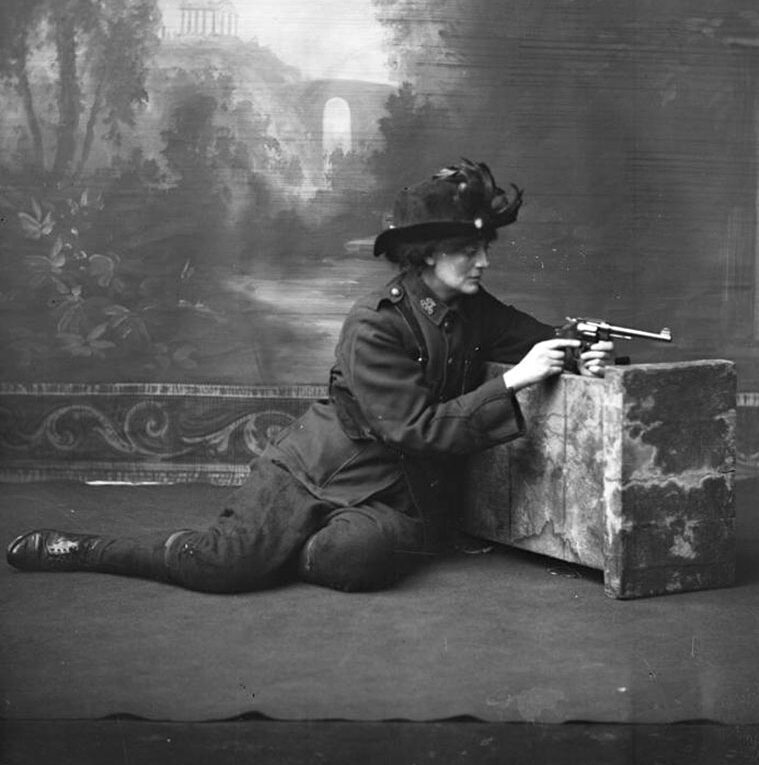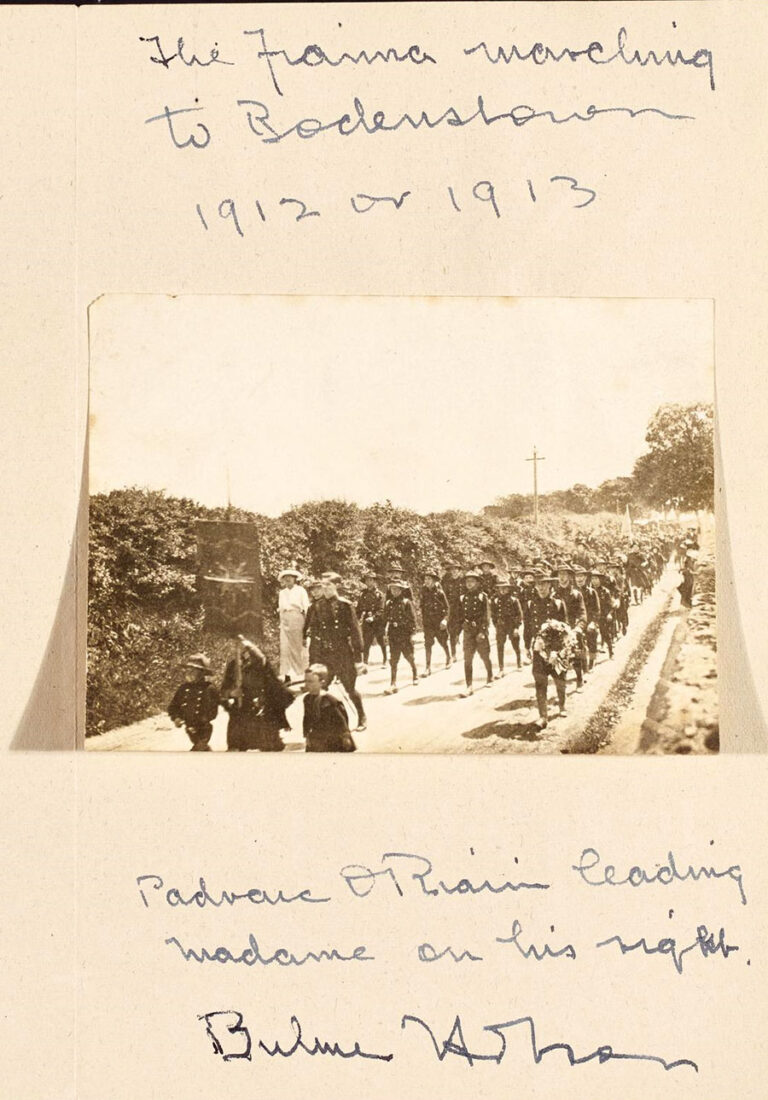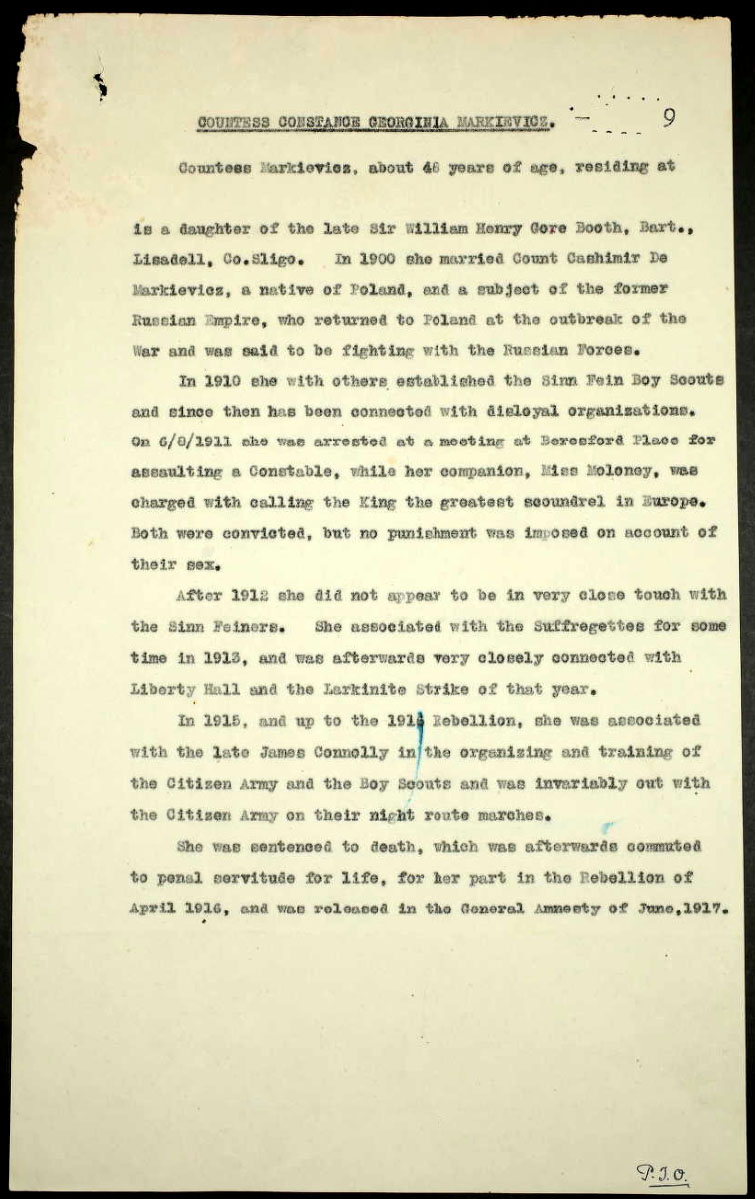Did you know that Nancy Astor (1879-1964) was not the first woman elected to British Parliament? This achievement belongs to ‘Countess’ Constance Markievicz, who was elected to serve for Sinn Féin and the constituency of Dublin St Patrick’s ward a year prior to Astor in 1918. However, as an Irish Nationalist, and along with 72 fellow Sinn Féin MPs, she refused to take her seat.

At this time Markievicz was in fact being held at Holloway Prison for anti-conscription activities – but this (her being in prison) was not unusual. A socialist and activist, Markievicz spent much of her political career in and out of prisons across Britain and Ireland. Documents including the Dublin Castle Papers (CO 904), held at The National Archives and available to view online via Ancestry, provide insight into the Countess’s revolutionary activities, the British Government’s monitoring of her, and her subsequent multiple arrests. Using these documents, I will shed light on the early life of the Rebel ‘Countess’, leading up to the 1916 Easter Rising.
An Irish nationalist, a socialist, and a suffragette, the Countess dedicated her life to the rights of women, to Irish nationalism, and to Ireland’s people. A remarkable life, especially considering that Constance Markievicz, née Gore-Booth, was born (4 February 1868) an Anglo-Irish aristocrat at a time in which women were actively excluded from the male-dominated world of politics[ref]It is worth noting that Constance’s younger sister, Eva, was also a renowned poet, trade unionist, and suffragette in Britain, particularly involved in women’s and labour campaigns in the North of England. Due to its Anglo-centric focus, Constance was a somewhat reluctant suffragette, but put her Republican politics to one side to support the suffrage movement.[/ref].

Those that are familiar with Markievicz because of her involvement in the 1916 Easter Rising may be surprised to learn that she in fact had an extremely privileged upbringing. Eldest daughter of adventurer and explorer Sir Henry Gore-Booth and Lady Georgina, she spent much of her childhood between London and the grand family home Lissadell House.
Her father’s compassion for others is believed to have greatly influenced Constance and Eva’s own social concerns and political ideals, especially during the Irish Famine of 1879, throughout which Gore-Booth ensured that his staff and tenants had access to enough food. This turbulent time in Irish history opened the Gore-Booth sisters’ eyes to the plights of the poor, and for Constance in particular, the struggles of the Irish under British rule.

It was not until she began studying at the Slade School of Art in London that Markievicz herself first became politically active, joining the National Union of Women’s Suffrage Societies in 1892. Following her marriage to Casimir Markievicz in 1900 and the birth of their daughter in 1903, the young family settled in Dublin, where the Countess’s particular involvement in nationalist politics became more prominent, joining the republican Sinn Féin party and radical women’s organisation Inghinidhe na hÉireann (Daughters of Ireland) in 1908[ref]The founder of Sinn Féin, Arthur Griffith, brought various republican separatist groups together to form one organisation with a shared aim – ‘the re-establishment of the independence of Ireland’ (Constance Markievicz: An Independent Life, Haverty, 71). Inghinidhe na h-Éireann was founded eight years prior by fellow female revolutionary and friend of Markievicz’s, Maud Gonne, who similarly prioritised ‘the re-establishment of the complete independence of Ireland’ while philosophically ‘indentif[ying] with the ‘republican force’ tradition’ (Haverty, 72).[/ref].
During this time, Markievicz formed strong bonds with the Irish Republican Brotherhood (IRB) and the high-ranking members that became the driving force towards the 1916 Easter Rising. These included Bulmer Hobson, Thomas Clarke, Partick McCarten and Seán McGarry, to name but a few. Despite her official exclusion from the brotherhood as a result of her gender, Markievicz herself explains how the IRB ‘educated me and took me under their wing, explaining to me all the intricacies of such simple things as organizations and committees’[ref]Eire, 28th July 1923, quoted in Haverty p. 74.[/ref].

This revolutionary education inspired Markievicz to take a more active role in Irish nationalist politics. In 1909, alongside Hobson, she founded the para-military youth organisation Fianna Éireann and acted as the group’s President. The Fianna were actively involved in the Easter Rising of 1916 and sadly many young boys were severely injured or lost their lives in the fighting.
Over the course of the next seven years her position as a loyal republican and her devotion to ‘disloyal organisations’ became increasingly evident. She was arrested for the first time in 1911 along with Helena Maloney for their participation at an IRB demonstration, protesting against King George V’s visit to Ireland. Maloney was arrested for damaging images of the King and Queen, while Markievicz was arrested for successfully attempting to burn a Union Jack flag and injuring a policeman in the process. Documents reveal that ‘both were convicted, but no punishment was imposed on account of their sex’ (CO 904).

Documents also reveal that ‘in 1915 and up to the 1916 Rebellion, she was associated with the late James Connolly in the organising and training of the Citizen Army and the Boy Scouts and was invariably out with the Citizen Army on their night route marches’ (CO 904)[ref]The Fianna were also referred to as the Irish National Boy Scouts.[/ref][ref]Connolly was one of 16 rebels executed for their involvement in the events of 1916.[/ref]. The Irish Citizen’s Army (ICA), a growing force of nationalist volunteers, formed during the 1913 Dublin lock-out to protect participants at anti-imperial and workers’ protests[ref]The Dublin lock-out started as an attempt to improve working rights, working conditions, and the right to unionise. The dispute lasted for almost seven months during which various political and radical groups were formed. Markievicz is said to have supported workers and their families in a variety of ways during this turbulent period, recruiting volunteers to provide aid, ensuring enough food for affected Dubliners, and even taking out loans and selling her belongings to support the cause financially. Many were injured during violent clashes with the police, and three participants are known to have died (James Nolan and John Byrne, and Michael Byrne who was tortured in police custody).[/ref]. In her biography Anne Haverty writes, ‘all her aspirations found a voice in this little army, the cause of Ireland, the cause of the people, the cause of women, and her thirst for action’[ref]Constance Markievicz: An Independent Life, 118.[/ref]. As the ICA grew substantially in size, so did their violent encounters with the police. But this did not deter the group which was, like Markievicz herself, determined to see Ireland gain independence from Britain.
After many years of preparation, by 1915 the groups with which the Countess had been involved (Sinn Féin, IRB, Fianna, ICA) joined forces to make a momentous decision – on Easter Sunday 1916 they would lead a revolution against the Crown. The subsequent events known as the Easter Rising would change the course of Irish history and solidify Constance Markievicz’s place as an Irish rebel and revolutionary.
In the next blog post I will explore her involvement in the revolution itself, her subsequent arrest and imprisonment, the many more arrests that followed over the years, as well as her political legacy.
This was a great read, really looking forward to part two!
By a strange coincidence I decided to research this woman on the very day this post was published.
I had only just started so this post was most welcome.
From what little I have found so far, her spell in Holloway mentioned above may have been following her arrest on 17 May 1918 when she and thirty other prominent Irish Republicans including Eamon de Valera – were arrested for their involvement in the ‘German Plot’.
This was an alleged attempt by the German government and Irish nationalists to hamper the war effort by diverting troops destined for the Western Front to quell (another) armed insurrection in Ireland.
The arrests were seen as a crude attempt to silence the attempts to oppose conscription to the British forces which had been passed by the Westminster government in April 1918.
I am no specialist on Irish history and may be putting things together in a nonsensical way, so please correct any facts I may have wrongly interpreted.
One very small but significant (and commonplace) error has crept into this post.
The national flag of the UK is often erroneously called the Union Jack.
It’s officially the Union flag and only becomes a ‘jack’ when flown from the jackstaff on Royal Navy vessels.
Apologies for being pedantic but I can easily imagine the burst blood vessels and fits of apoplexy that might have occurred if it had gone unremarked.
And I think we all agree that the NHS has enough to cope with at the moment!
Brilliant.. I so often got into debates about this. As I’m Irish it was one of the few firsts for our women and many of my British friends wouldn’t believe me. I am very curious to know was there any official letter declaring her refusal to accept the seat?
Thanks
On a second note: During the Dublin lockout many British families from Workers Unions in the North of England sent money and support to the Irish families affected by the lockout. James Connolly was a Scottish Union leader and Margret Skinnider another great Scottish socialist both got involved in Irish politics through workers rights and unions.
Hi Richard
The German Plot was a convenient way of arresting a large group of Irish Nationalist who were against British rule in Ireland, in general organising public gatherings and rallies for elections, writing public propaganda, anti-conscription and attending illegal Nationalist events. It was more than this but the plot itself was never validated.
About 15,000 Irish Volunteers were against fighting for Britain during WW1 yet 250,000 Irish volunteers fought. In 1916 Roger Casement and several others did liaise with the German’s to buy arms for the Easter Rising. He got caught and executed. He also was an elected member of parliament and wrote amazing reports about treatment of workers in the Congo under the Belgium Leopold.
Fascinating angle on this period. Casement and Alice Stopford Green really interesting characters living in England.
Back in the early 70s my husband and I were on holiday in County Sligo. After leaving Mullaghmore we happened to come across Lissadell House. There was no one about but the doors were open. We were unsure whether or not to go in until an elderly man appeared who had been working on the surrounding land. We asked if we could go inside and he said “sure, no one often comes here”. He had left the doors open to air the place. I found what must have been a beautiful house was then in a sad state of decay. The large wall tapestries were threadbare and damp, the smell of damp and decay everywhere. The original furniture remained but again looked a very tired. I have often wondered if what had once been such a beautiful house had ever been restored.
Hello Jen,
Thank you for the information regarding the German Plot.
I freely admit to not knowing enough about the history of the island of Ireland in the 20th century, despite a little Irish heritage in my background.
I have always found it useful to bear in mind three things… it’s very complicated, never black and white and you’ll never know as much as the next person.
But that doesn’t stop it from being a fascinating subject.
Sorry Jen, I didn’t see your remark about an official letter declining to take up the parliamentary seat.
Didn’t those who refused to go to Westminster both in 1916 and subsequently just not go, leaving the seat theirs in name?
I know (a dangerous word in this context) that Bobby Sands was in prison and on hunger strike when he became MP for Fermanagh and South Tyrone.
The sticking point for MPs would have been swearing an oath of allegiance to the King. It may interest people to know that before the Rising som nationalists in London including De Valera trained in the German Gymnasium in Kings Cross, which survives as a bar/restaurant
Thanks so much for this information. I once had a biography of Constance called Rebel Countess. I encountered it a second time several years later. It was in the library I had that for some time was with my “former” lover. I wonder if he ever read it…